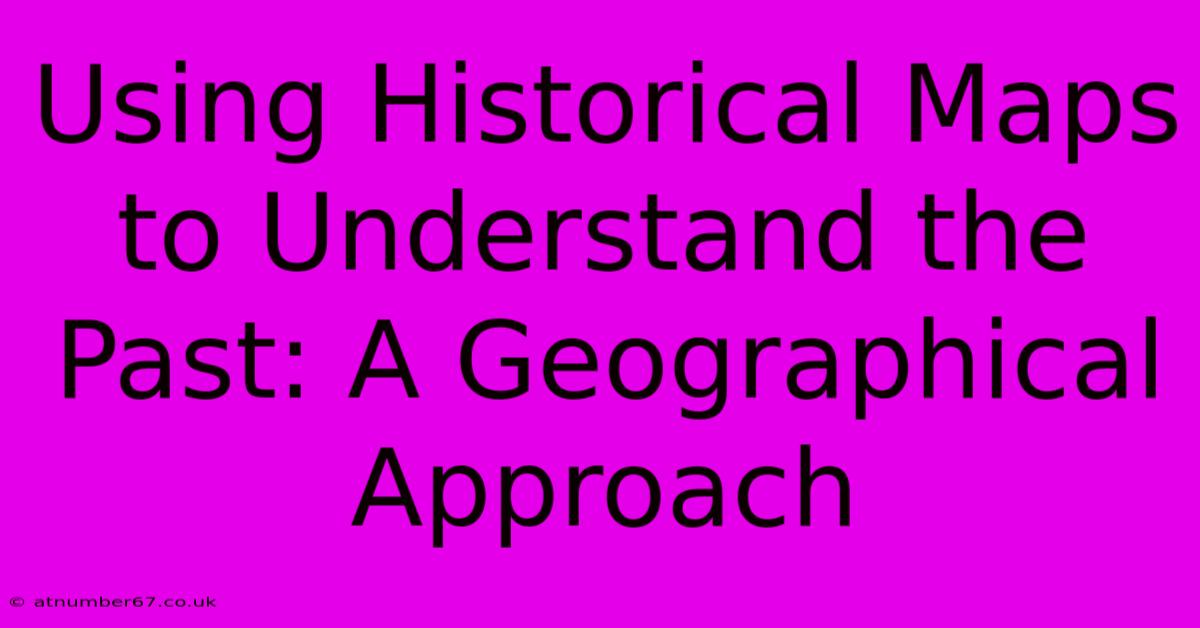Using Historical Maps To Understand The Past: A Geographical Approach

Table of Contents
Using Historical Maps to Understand the Past: A Geographical Approach
Historical maps offer a unique window into the past, providing invaluable insights beyond simple textual accounts. They are powerful tools for understanding the evolution of societies, economies, and environments. This geographical approach to history allows us to visualize and analyze the spatial dynamics that shaped past events. By examining these cartographic records, we gain a deeper understanding of human history and its complex interplay with the physical world.
Decoding the Landscape: What Historical Maps Reveal
Historical maps aren't just pretty pictures; they are rich repositories of information. They reveal much more than just geographical locations; they illustrate the perspectives and priorities of the mapmakers themselves. Analyzing these maps requires a careful consideration of several factors:
1. Cartographic Conventions and Styles:
Different eras employed distinct cartographic conventions. Understanding these conventions is crucial for accurate interpretation. For example, early maps often used symbolic representations of features, while later maps adopted more standardized conventions. Recognizing these stylistic variations allows us to better understand the map's context and intended audience. Consider the scale, projection, and symbols used—each choice reflects the mapmaker's intent.
2. Thematic Content:
Historical maps aren't limited to simple geographical representations. Many maps are thematic, focusing on specific aspects of a region, such as population density, resource distribution, or political boundaries. Analyzing thematic maps allows us to understand the spatial distribution of particular phenomena and their impact on historical events. For instance, a map showing the distribution of railroads in the 19th century reveals insights into industrial growth and economic development.
3. The Mapmaker's Perspective:
It's crucial to remember that maps are not objective representations of reality. They reflect the biases, knowledge, and perspectives of their creators. A map created by a colonial power, for example, might emphasize areas of resource extraction while minimizing indigenous settlements. Understanding the mapmaker's perspective is vital for a nuanced interpretation.
4. Evolution over Time:
Comparing maps from different periods reveals fascinating changes in landscapes, settlements, and political boundaries. Tracking these changes over time offers a dynamic understanding of historical processes. For example, comparing maps of a city over several centuries can show its growth, changes in infrastructure, and the shift in its economic and social center.
Beyond Borders: Applications of Historical Maps
The applications of historical maps are diverse and extend far beyond the traditional realm of history:
- Urban Planning: Studying historical maps helps urban planners understand the evolution of cities, identify historical patterns, and make informed decisions about future development.
- Environmental History: Maps can reveal changes in ecosystems, deforestation patterns, and the impact of human activities on the environment.
- Archaeology: Historical maps provide valuable context for archaeological investigations, helping to locate potential sites and understand past landscapes.
- Genealogy: Maps can aid in genealogical research by tracing family migrations and identifying historical locations of ancestors.
- Military History: Studying military maps provides insight into strategic decisions, troop movements, and the geography of battles.
Accessing and Analyzing Historical Maps
Numerous resources are available for accessing historical maps:
- National Archives: Many countries have national archives containing vast collections of historical maps.
- University Libraries: University libraries often possess extensive map collections.
- Online Databases: Several online databases offer digitized historical maps, providing easy access to a wealth of information.
- Local Historical Societies: Local historical societies frequently hold collections of maps relating to their specific region.
By mastering the skills of interpreting historical maps, we unlock a deeper understanding of the past. This geographical approach offers invaluable insights, enriching our comprehension of human history and its enduring relationship with the physical world. The detailed information gleaned from these sources provides a richness of context unavailable through textual sources alone, making them an essential resource for researchers and history enthusiasts alike.

Thank you for visiting our website wich cover about Using Historical Maps To Understand The Past: A Geographical Approach. We hope the information provided has been useful to you. Feel free to contact us if you have any questions or need further assistance. See you next time and dont miss to bookmark.
Featured Posts
-
Precise Sugar The Key To Perfect Recipes
Apr 12, 2025
-
The Real Story Behind Sebastian Dobrincus Net Worth
Apr 12, 2025
-
Kylie Jenners Age A Critical Analysis
Apr 12, 2025
-
Chile Election Date Prepare For The Vote
Apr 12, 2025
-
Farrah Teen Mom A Story Of Redemption
Apr 12, 2025
